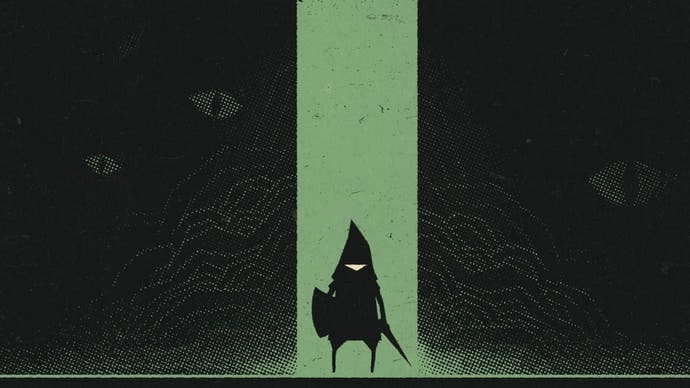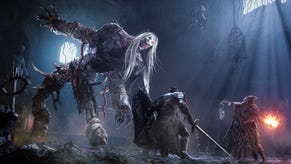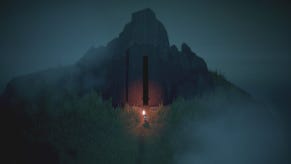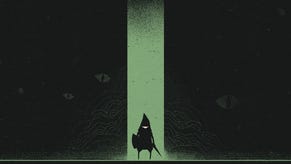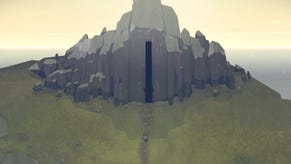I think I like Below the most when I'm not actually playing it
Down, down and deeper.
Before I went home for Christmas last year, I had two firm ideas about Below based on, admittedly, only about ten hours of playing it. The first idea was that the game was a bit of a well-intentioned botch. The second was that, combat and exploration aside, what Below was really concerned with was fostering the slow realisation in its players that game design itself is probably one big roguelike.
My argument for this second point went something like this. Roguelikes - and roguelites, if you're willing to allow the term - are so good at creating stories because you have to commit. To play is to make decisions in a roguelike, and in a roguelike you have to live by those decisions to the very end. Below is definitely a roguelike (or maybe a roguelite, if you're willing to allow the term). Anyway, it's a dungeon-crawler: you wash up on an island, you mooch about in the beautiful pixel drizzle for a bit and then you discover a mountain with a very tall slot in it. It's a negative-space Monolith, beckoning to you from some kind of elongated version of 2001 (a negative-space odyssey).
In you go, and sure enough there are themed levels of dungeon to explore as you go down, down, down, navigating procedural rooms and their increasingly tricksy beasties as you grapple with shield-heavy combat and typical survival stuff that sees you expiring, over time, through hunger, thirst and the cold unless you salvage the things you need to see this triple-threat off for the time being.
The crucial part of that last paragraph is this: sure enough. And for this pre-Christmas theory of mine, here's the really important thing about this game that I've left out until now: Below is absolutely stunning to look at. Its rocks and icicles and tombs are angular and stark, its rain and grass are beautifully animated, its camera is pulled far, far back so that your tiny adventurer feels terribly alone. Enemies are increasingly great, some of the tile-sets are completely unexpected - an ossuary I was pretty much counting on, but there's an area in here that looks like a next-gen Apple Store that sprouts mazes from the floor? - and at its best the game is willing to hold a single moment for a really long time: a staircase that takes an age to descend, a corridor that seems to go on forever. David Lean was once asked about what he took away from Lawrence of Arabia after he watched it again for the first time many years after making it. He said he was proud of himself for holding certain shots for such a long time. David Lean would love Below.

But sure enough: Souls-alike combat, procedural tilesets, survival mechanics and the attendant crafting. The problem here wasn't that these individual pieces felt so tired, because lots of games use them and mint enormous fun from them. It's not even that they're punishingly applied, because lots of games aim to be entertainingly punishing and that's obviously fine too. The problem I had with Below is that these elements felt completely unharmonious with the art. Below's whole vibe, conjured by that beautiful, delicate, wild, ancient art, is one of mysteries: real mysteries lurking down there in the depths, secret knowledge waiting to be teased out. But the problem is: Souls combat, survival stuff, crafting? These all work against any kind of mystery. I absolutely know how they work, and I absolutely know what they mean. And what do they do to a vista of wilderness and the unknown? My initial conclusion was that they absolutely destroyed it. Because they teach you to seek out the parts of the world that you do understand - the parts that promise crafting or progress - and ignore the rest. Below's mechanics seemed to render its beautifully painted worlds bland and utilitarian, and I hated them for doing that.
Hate is a bit strong. This approach certainly annoyed me at first. It annoyed me that a game with such bespoke art would choose what seemed to be such placeholder mechanics. It annoyed me that a game could be so confident in how it looked - with a beautiful logo from a name designer - but so unimaginative, so strangely lacking in confidence, in how it played. But then I started to think about why that might be. I began to think about why the clearly talented team at Capybara stuck with a game like Below for so long when I suspected they knew pretty well that the whole thing wasn't coming together very easily.
And here was the kernel of my initial theory: game development is hard, and survival for an indie, even a storied, charismatic, popular indie, is precarious. So when you hit on an art style that moves people, if you are an art-led studio, you cleave to it. You grab it and hold on tight. And you make a logo, and you probably make T-shirts and reusable water bottles and throw cushions and all that beautiful jazz, because by God, you've got something people respond to and that suggests a little bit of certainty in this terrifying marketplace. And you stick with the game, even if the game simply isn't coming, even if the only things that work are the most basic, tedious, busywork elements that steadily kill the player and give them something to at least do - who doesn't like something to do, I guess? - while they're exploring this astonishingly evocative world that you created and which is now perhaps a bit of an albatross.
In other words, faced with danger and disaster on all sides, you have to commit.

So that was Below as it existed in my head at the point I left it for the Christmas break. I figured I'd play it some more over Christmas and if I didn't like it any more by then I'd write up some kind of piece on my smug, idiotic argument about the game being a roguelike that hinted that game design was also a roguelike and then I'd get on with my life.
Here's the thing, though: I didn't play it some more over Christmas, because I really, really don't enjoy playing Below for all the reasons stated above. Fine. But what's weird is that instead of playing it, I just found myself thinking about Below an awful lot - and the Below I found myself thinking about is a game that I actually sort of love.
Below blooms in the mind when you aren't playing it. It does for me, at least. The art seems wilder, darker, more filled with promising shadows, the narrative seems more teasing, more richly stuffed with the potential for strange interpretations. And the frustrations with the placeholder mechanics? They absolutely disappear. Stepping away from Below allowed Below to grow in my imagination, I think, to take root. And the workaday world of what you actually do in the game evaporated almost instantly, returning only when I thought about sitting down and firing the game up again. The mechanics clearly weren't the real point here after all.
This realisation was probably predictable. The relentless ticking of Below's annoying systems can make the game feel claustrophobic in the worst sense when you're playing it - but when you step back, they dwindle, and the claustrophobic worlds suddenly breathe out and feel a little more spacious. Little design elements suddenly shine more brightly. Sometimes they even make you think: Hmmm. How did I miss that?
A good example of this is the corpse you leave when you die. Lots of games involve corpse-running to collect your old stuff, and in Below you reclaim your last adventurer's belongings from what looks like a bleached white skeleton lurking in one of the chambers. The first time I did this I was still in the very early parts of the game, so the skeleton was lying on grass and the grass poked through the ribcage, a bit like Fresleven, one of many racist jerks who gets himself killed in Heart of Darkness.
Then over Christmas I found myself thinking: wait, hasn't Fresleven been dead for really quite a long time by the point that Marlow gets to him? Isn't that why he's a skeleton? And then I thought: just how much time is passing between one adventurer's run and the next in Below? In the game, it's all but instantaneous (or as close to being instantaneous as a game like Below can handle). One guy dies and then there's the boat with your next guy arriving on the frosty shoreline. But the fact your previous guy is now a skeleton muddles the timeline. This game, I like to think, is actually built on tantalising gaps, on secret editing. Maybe long periods of time pass between one adventurer finding the island and the next? Maybe whole epochs lie in the space between cuts. (And we're back to 2001.)
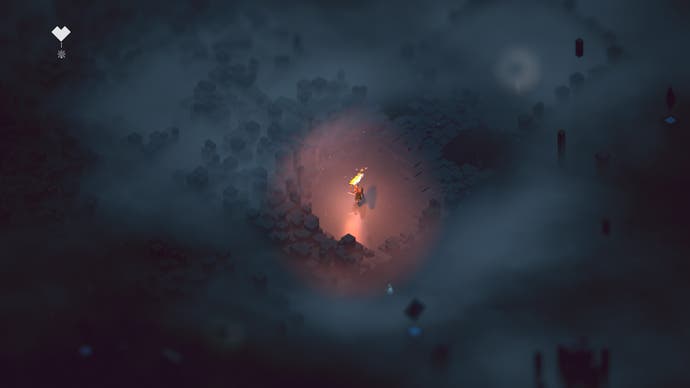
Then there's the magical lantern you carry in Below, your only real ally down there in the darkness, allowing you to interact with equally magical bits and pieces by shining a light around you. But the more I thought about Below over Christmas, the more I started to ponder: is the lantern really your ally? Isn't the lantern very nearly a neat metaphor for something like mitochondrial DNA, the spooky coils of genetic code that remain unchanged for millions of years, passed down from mother to child? We are but the feeble temporary vessels of mitochondrial DNA, while it will get to bask in the final toxic rays of our exploding sun, probably, long after we have been discarded. Such is the case with that lantern. You die and you drop it and then you have to find your way back to it on your next life. It is somewhat creepy to realise that, as you hustle up and down, the lantern only ever moves forward.
Brilliantly, when I did finally fire up Below again this morning, it looks like some of the lantern stuff has actually been patched out. When I died deep in the caves this time, the lantern was now waiting for me on the beach for my next adventurer. Maybe a patch, maybe I simply hit a point in the game where the mechanics change. For all my griping, I'm still not really that far in.
And that's the final part of the whole thing for me. Stepping away from Below has allowed me to understand that the game itself is changing, as Capybara patches and tweaks and responds, I would imagine, to player criticism. And when I go on Reddit where there is a very busy and joyous Below community, I realise that for a lot of people Below was precisely the game they wanted anyway: they could cut through the busywork, and strongly disagree that it even is busywork in fact, and still find a thing of glittering mystery waiting for them on the other side of the screen.
This may be how I end up playing Below in the long run. For me, it's a game to watch from a distance and ponder, as if it's out there in the Kuiper Belt, twisting through the darkness, bound by mysterious forces.
It reads, I know, like the sickest of burns to say that you only enjoy a game when it's safely switched off and you're doing something else. But, stupid as it is, I think there's a strange bit of truth in there about the way I actually enjoy games. Years ago when I played Lucasarts stuff like Monkey Island and Maniac Mansion, my school friends and I would ponder how you could play these games without having them there in front of you. You could play Maniac Mansion in maths class if you wanted, by thinking about the puzzle you were currently stuck on in-game, thinking about the items you had and the objects you might use them on. That was definitely a form of playing. Below is not, as far as I am aware, a point-and-click adventure game, but I think it has some strange strain of the same appeal. The whole thing aims to be a puzzle, and there is a great attendant puzzle involved in how it has come to be and how it may ultimately end up after any post-release tweaking.
So while I don't want to prod through much more of Below myself (and I don't really need to have it solved for me), despite its irritations I'm still kind of glad it's out there. And anyway, it's clearly working some sort of magic on me whether I want it to or not.
